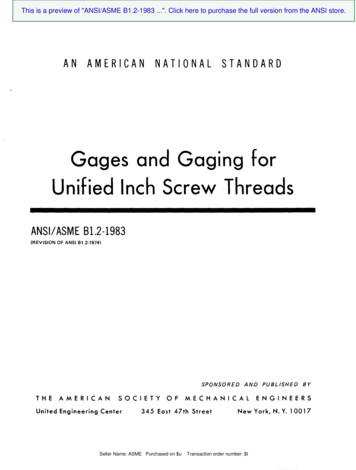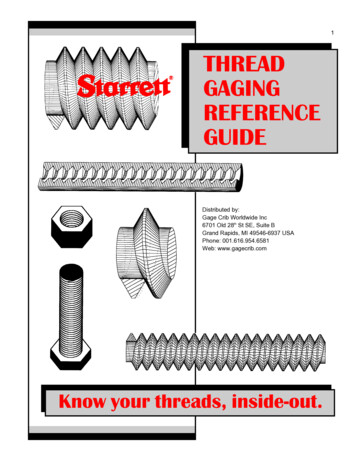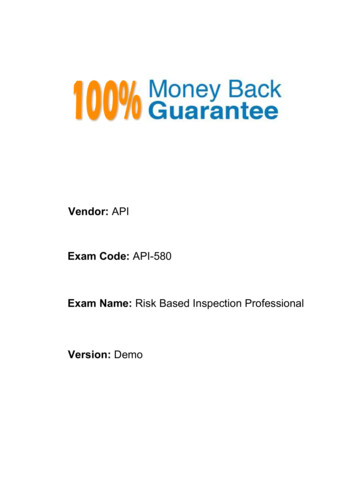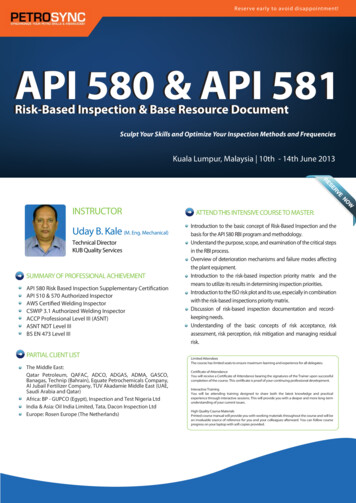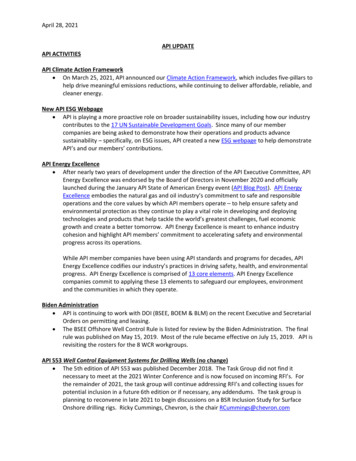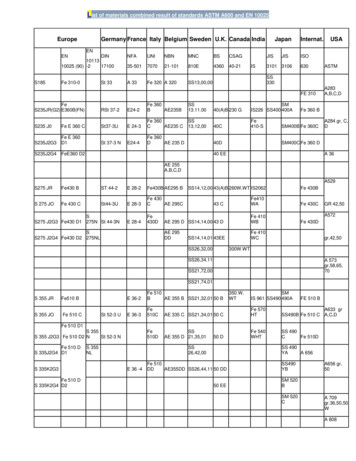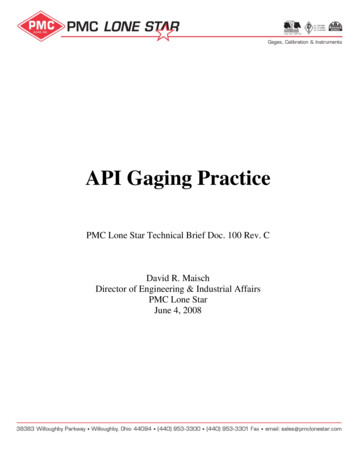
Transcription
API Gaging PracticePMC Lone Star Technical Brief Doc. 100 Rev. CDavid R. MaischDirector of Engineering & Industrial AffairsPMC Lone StarJune 4, 2008
The American Petroleum Institute (API), headquartered in Washington, DC, USA is aworld leader in the development of standards for all aspects of the oil and natural gasindustry. When using API sanctioned gages for the inspection of products or calibrationof other gages, it is critical that the user have a high quality gage, manufactured using thearSt fene riLo l BC icanPM chTelatest manufacturing and inspection technology available. Gages should be manufacturedso that they meet or exceed API specifications.Each API working gage shall be accompanied by a certification listing the values withdimensions measured for each critical element, as well as a measured standoff to acertified master gage. Each API master gage shall be accompanied by a certificationfrom an API qualified agency such as the National Institute of Standards and Technology(NIST) located in Gaithersburg, Maryland, USA, the National Physical Laboratory (NPL)located in the United Kingdom, or the National Institute of Metrology (NIM) located inBeijing, The People’s Republic of China, as described in the API specifications. For APISpecification 5B, the API approved certifying agency shall perform a full inspection onall critical elements as well as a mating standoff, and provide a report detailing the resultsof the inspection. For API Specification 7, the API approved certifying agency shallperform a full inspection on all critical elements as well as a standoff against theappropriate regional or grand master gages and a mating standoff. A certification shall beprovided detailing the results of the inspection.
The gage tolerancing defined by API is designed to allow the gage manufacturertolerance for manufacturing the gage while still providing the end user with tolerance forwear of the gage. Due to the desire for maximum wear life of gages, it is often requestedthat gages be manufactured on the plus side of the tolerance. Manufacturing to the plusarSt fene riLo l BC icanPM chTeside of the tolerance does not always provide desirable results. It is possible thatmanufacturing to the plus side of the tolerance will lead to one laboratory performinginspection and standoff near the maximum limit while another laboratory, using differentmaster gages will find that the gages exceed the allowable tolerances and they willquestion the validity of the gages. This situation can arise very easily for APISpecification 5B gages because the taper ratio is 16:1 and even small differences indiameter can result in large differences in standoff. For this reason, it is PMC LoneStar’s practice to manufacture all gages as close to nominal size as possible. When thereis a difference between the API accredited manufacturer’s reported results and anotherAPI accredited laboratory’s reported results, it does not mean that the gages are out oftolerance and should be rejected. It simply means that the two inspecting laboratorieshave master gages which differ in size from one another. In cases such as this, theinspection results provided by the API accredited manufacturing and inspection facilityshould be accepted and used with the gages. It is also recommended that the resultsprovided by the local laboratory be recorded for future comparison when checking forwear. Manufacturers of product threads shall conform to the gaging requirements as
stated in API Specification 5B, Fifteenth Edition, April 2008 Paragraph 6.1.2. SeeFigure 1.arSt fene riLo l BC icanPM chTeThe manufacturer of product threads shall also provide working gauges conforming tothe requirements of 7.1.2 for use in gauging the product threads, and shall maintain allworking gauges in such condition as to ensure that product threads, gauged as requiredherein, are acceptable under this specification. The manufacturer shall establish anddocument a program of measuring the wear (interchange standoff of working gaugeswith master gauges) on each working ring and plug gauge that is used in the productionof API threads. Included in this program shall be detailed procedures, frequency ofmeasuring wear, and criteria of rejection that completely decommission a working ringor plug gauge from any further use. The results of each required measurement for eachworking ring or plug gauge shall be documented. The records of procedures andmeasurements shall be maintained for not less than 3 years following the last usage ofeach gauge. The manufacturer shall also establish and document a frequency forinspecting product threads with working gauges based on his control of themanufacturing process.Figure 1. - API Specification 5B Paragraph 6.1.2, Gauge RequirementsThe tolerances and standoff criteria for API Specification 5B are often misunderstood.When a set of API Specification 5B masters are manufactured, the report thataccompanies the gages includes a mating standoff value “S” which is used to monitorwear. As stated in API Specification 5B, Fifteenth Edition, April 2008, Paragraph 6.1.6,the mating standoff value “S” is acceptable as long as it falls within the tolerancesspecified by API Specification 5B. See Figure 2. A mating standoff value “S” which isat low limit of the tolerance range is not an indication of reduced wear life, just likea standoff value “S” which is at the high limit of the tolerance range is not anindication of increased wear life
A pair of master gauges (master plug and mating master ring) which have been tested asprescribed in 8.1.4 may be considered acceptable for continued use provided the matingstandoff remains equal to the original certified standoff “S” (as stamped on the ringgauge), or does not change from this original value more than that shown below.arSt fene riLo l BC icanPM chTeFor line pipe gages the mating standoff shall not increase from the original “S” value bymore than the equivalent of 1/10 thread turn for all pitches and sizes, and shall notdecrease from this original value by more than 1/8 thread turn for 27-thread and 18thread (per in.) gauges, 5/32 thread turn for 14-thread and 11-1/2 thread gauges, or 5/32thread turn for 8-thread gauges for line pipe in nominal sizes 8 and smaller, and 1/5thread turn for 8-thread gauges for line pipe in nominal sizes 8 and larger. See Table 1.For round thread casing and tubing gauges, the mating standoff shall not increase fromthe original S value by more than the equivalent of 1/10 thread turn for all pitches andsizes and shall not decrease from this original value for 8-thread gauges by more than5/32 thread turn for sizes 8-5/8 and smaller, 1/5 thread turn for sizes 9-5/8 and larger,and 1/5 thread turn for all 10-thread gauges. See Table 2.For buttress thread casing gauges the mating standoff shall not increase from theoriginal S value by more than the equivalent of 1/16 thread turn for all sizes and shall notdecrease from this original value by more than 1/10 thread turn for sizes 8-5/8 andsmaller, and 1/8 thread turn for sizes 9-5/8 and larger. See Table 3.Figure 2. – Gauge API Specification 5B Paragraph 6.1.6, Gauge Acceptance
Table 1. – “S” Value Wear Limits for Line Pipe"S" Value Decrease0.00460.00690.01120.01360.01950.0250arSt fene riLo l BC icanPM chTePitch27 T.P.I.18 T.P.I.14 T.P.I.11-1/2 T.P.I.8 T.P.I. (8 and Smaller)8 T.P.I. (8 and Larger)Line Pipe"S" Value Increase0.00370.00560.00710.00870.01250.0125Table 2. – “S” Value Wear Limits for Round Thread Casing and TubingRound Thread Casing and TubingPitch"S" Value Increase"S" Value Decrease8 T.P.I. (8-5/8 and Smaller)0.01250.01958 T.P.I. (9-5/8 and Larger)0.01250.025010 T.P.I.0.01000.0200Table 3. – “S” Value Wear Limits for Buttress Thread CasingPitch5 T.P.I. (8-5/8 and Smaller)5 T.P.I. (9-5/8 and Larger)Buttress Thread Casing"S" Value Increase0.01250.0125"S" Value Decrease0.02000.0250
The requirements for recertification of API gages vary by specification. For APISpecification 5B, an interchange standoff between working gages and master gage shallbe periodically performed in order to monitor and track wear of the working gages.Master gages shall be periodically tested for mating standoff. In both cases the timearSt fene riLo l BC icanPM chTeinterval between calibrations is based on the frequency of use of the gages, however,PMC Lone Star recommends that calibration be performed a minimum of once per year.For API Specification 7 working gages, gages shall be periodically retested for matingand interchange standoff against certified reference master gages. The time intervalbetween calibrations is based on the frequency of use of the gages, however, PMC LoneStar recommends that calibration be performed a minimum of once per year. APISpecification 7 regional and reference master gages shall be retested for mating andinterchange standoff at least once every seven years, reference master gages shall beretested against certified regional master gages, and regional mater gages shall be retestedagainst certified grand master gages. A certification including the mating andinterchange standoff shall be provided by the laboratory performing the calibration.In conclusion, it is critical that only the highest quality gages are used to check product.All gages should be manufactured and certified by an A.P.I accredited facility whichmaintains A.P.I certified master gages. It is equally important that API gaging practicesare fully understood and followed at all times to ensure the highest quality productpossible.
BibliographyAmerican Association for Laboratory AccreditationA2LA ISO 17025arSt fene riLo l BC icanPM chTeAmerican Petroleum InstituteAPI Specification 5B, Fifteenth Edition: Specification for Threading, Gaugingand Thread Inspection of Casing, Tubing, and Line Pipe ThreadsWashington, DC: April, 2008American Petroleum InstituteAPI Specification 7, Fortieth Edition, Addendum 1: Specification for Rotary DrillStem ElementsWashington, DC: November, 2001American Petroleum InstituteAPI Specification Q1, Eighth Edition: Specification for Quality Programs for thePetroleum, Petrochemical and Natural Gas IndustryWashington, DC: December, 2007
The requirements for recertification of API gages vary by specification. For API Specification 5B, an interchange standoff between working gages and master gage shall be periodically performed in order to monitor and track wear of the working gages. Master gages shall be periodically tested for mating standoff. In both cases the time
![API Ballot: [Ballot ID] – API 510 & API 570, Deferrals, Rev05](/img/5/api510andapi570deferralsrev5.jpg)
